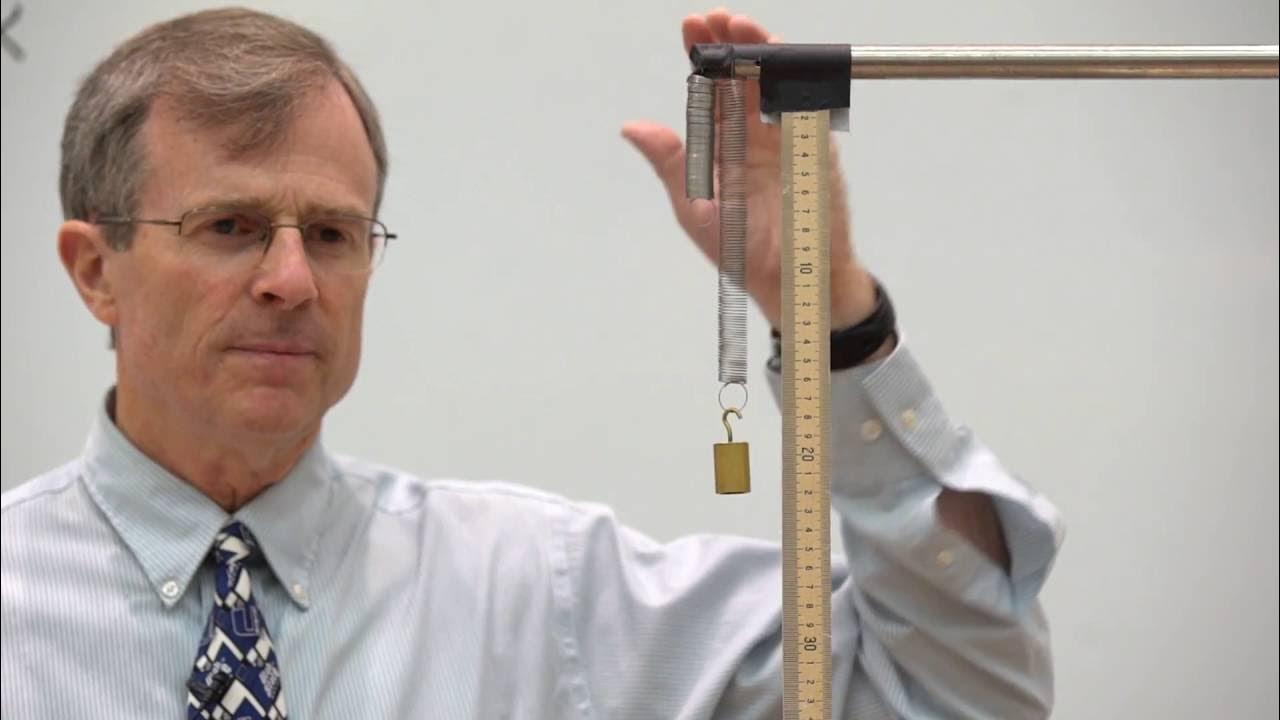Simple Harmonic Motion Introduction(SHM) via a Horizontal Mass-Spring System
Summary
TLDRThis video demonstrates the principles of a horizontal mass-spring system, explaining simple harmonic motion. A mass is attached to a spring, and the video walks through the process of displacing the mass, observing the forces at play. Key concepts such as equilibrium, Hooke's law, restoring forces, and oscillation are explored. The spring force is shown to be proportional to the displacement, leading to continuous oscillation in the absence of friction. The video educates viewers on the mechanics of the system, reinforcing the concept of restoring forces and the behavior of the mass in simple harmonic motion.
Takeaways
- 😀 A horizontal mass spring system involves a mass attached to a spring on a frictionless surface.
- 😀 The equilibrium or rest position is the state where the mass experiences no force from the spring.
- 😀 When the mass is displaced from its equilibrium position, the spring force acts in the opposite direction of the displacement.
- 😀 The spring force accelerates the mass towards the equilibrium position after it is released from a displaced state.
- 😀 The mass continues to oscillate through the equilibrium position, reaching maximum displacements to both the left and right.
- 😀 In the absence of friction, the oscillation will continue indefinitely, as the system follows simple harmonic motion.
- 😀 Simple harmonic motion requires a restoring force that always pulls the mass back to the equilibrium position.
- 😀 The restoring force must be proportional to the displacement from the equilibrium position, as described by Hooke's Law.
- 😀 Hooke's Law states that the force of the spring is equal to the negative of the spring constant (k) times the displacement (x).
- 😀 The force of the spring increases as the displacement from equilibrium increases, ensuring a proportional relationship.
- 😀 Simple harmonic motion will persist indefinitely in the absence of friction, with the mass oscillating between maximum displacements on either side.
Q & A
What is a horizontal mass-spring system?
-A horizontal mass-spring system is a setup where a mass is attached to a spring that is oriented horizontally and placed on a frictionless surface.
What happens when the mass is at rest in the mass-spring system?
-When the mass is at rest, the spring is in its equilibrium position, and the force acting on the mass is zero.
How is the equilibrium position indicated in the system?
-The equilibrium position is indicated by a dotted line in the system.
What happens when the mass is displaced to the right of the equilibrium position?
-When the mass is displaced to the right, the spring force acts in the opposite direction, pulling the mass back toward the equilibrium position.
What is Hooke’s Law, and how does it apply in this system?
-Hooke’s Law states that the force of a spring is proportional to the displacement from its equilibrium position, with the force acting in the opposite direction of the displacement.
What happens when the mass passes through the equilibrium position?
-When the mass passes through the equilibrium position, it continues moving toward the opposite side of the equilibrium due to the spring force, reaching its maximum displacement in the opposite direction.
What is the direction of the spring force when the mass is at the equilibrium position?
-At the equilibrium position, the displacement is zero, and according to Hooke’s law, the spring force is also zero with no direction.
What is the direction of the spring force when the mass is at the maximum displacement to the left?
-When the mass is at maximum displacement to the left, the spring force acts to the right, pulling the mass back toward the equilibrium position.
What is simple harmonic motion in the context of this mass-spring system?
-Simple harmonic motion refers to the oscillation of the mass back and forth through the equilibrium position, in which the motion continues indefinitely in the absence of friction.
What are the two requirements for a force to cause simple harmonic motion?
-The two requirements are: 1) The force must be a restoring force, always directed toward the equilibrium position, and 2) The magnitude of the restoring force must be proportional to the displacement from the equilibrium position.
How does Hooke’s Law describe the relationship between the spring force and displacement?
-Hooke’s Law describes that the spring force is equal to the negative of the spring constant (k) multiplied by the displacement (x). As the displacement increases, the spring force also increases in magnitude.
Outlines

This section is available to paid users only. Please upgrade to access this part.
Upgrade NowMindmap

This section is available to paid users only. Please upgrade to access this part.
Upgrade NowKeywords

This section is available to paid users only. Please upgrade to access this part.
Upgrade NowHighlights

This section is available to paid users only. Please upgrade to access this part.
Upgrade NowTranscripts

This section is available to paid users only. Please upgrade to access this part.
Upgrade NowBrowse More Related Video

M H S aula 03

Contoh Soal Undamped Free Vibration (Seri Getaran Mekanis part2)

Comparing Simple Harmonic Motion(SHM) to Circular Motion - Demonstration

Demonstrating Position, Velocity, and Acceleration of a Mass-Spring System

Simple Harmonic Motion(SHM) - Force, Acceleration, & Velocity at 3 Positions

Oscillations Demo: Mass Spring System
5.0 / 5 (0 votes)